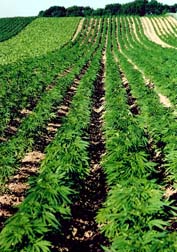Fuels made from Prairie Biomass reduce Atmospheric Carbon Dioxide
 Highly diverse mixtures of native prairie plant species have emerged as a leader in the quest to identify the best source of biomass for producing sustainable, bio-based fuel to replace petroleum.
Highly diverse mixtures of native prairie plant species have emerged as a leader in the quest to identify the best source of biomass for producing sustainable, bio-based fuel to replace petroleum.A new study led by David Tilman, Regents Professor of Ecology in the University of Minnesota’s College of Biological Sciences, shows that mixtures of native perennial grasses and other flowering plants provide more usable energy per acre than corn grain ethanol or soybean biodiesel and are far better for the environment.
“Biofuels made from high-diversity mixtures of prairie plants can reduce global warming by removing carbon dioxide from the atmosphere. Even when grown on infertile soils, they can provide a substantial portion of global energy needs, and leave fertile land for food production,” Tilman said.
Based on 10 years of research at Cedar Creek Natural History Area, the study shows that degraded agricultural land planted with highly diverse mixtures of prairie grasses and other flowering plants produces 238 percent more bioenergy on average, than the same land planted with various single prairie plant species, including monocultures of switchgrass.
Tilman and two colleagues, postdoctoral researcher Jason Hill and research associate Clarence Lehman, estimate that fuel made from this prairie biomass would yield 51 percent more energy per acre than ethanol from corn grown on fertile land. This is because perennial prairie plants require little energy to grow and because all parts of the plant above ground are usable.
Fuels made from prairie biomass are “carbon negative,” which means that producing and using them actually reduces the amount of carbon dioxide (a greenhouse gas) in the atmosphere. This is because prairie plants store more carbon in their roots and soil than is released by the fossil fuels needed to grow and convert them into biofuels. Using prairie biomass to make fuel would lead to the long-term removal and storage of from 1.2 to 1.8 U.S. tons of carbon dioxide per acre per year. This net removal of atmospheric carbon dioxide could continue for about 100 years, the researchers estimate.
In contrast, corn ethanol and soybean biodiesel are “carbon positive,” meaning they add carbon dioxide to the atmosphere, although less than fossil fuels. Switchgrass, which is being developed as a perennial bioenergy crop, was one of 16 species in the study. When grown by itself in poor soil, it did not perform better than other single species and gave less than a third of the bioenergy of high-diversity plots.
“Switchgrass is very productive when it’s grown like corn in fertile soil with lots of fertilizer, pesticide and energy inputs, but this approach doesn’t yield as much energy gain as mixed species in poor soil, nor does it have the same environmental benefits,” said Hill.
To date, all biofuels, including cutting-edge nonfood energy crops such as switchgrass, elephant grass, hybrid poplar and hybrid willow, have been produced as monocultures grown primarily in fertile soils.
The researchers estimate that growing mixed prairie grasses on all of the world’s degraded land could produce enough bioenergy to replace 13 percent of global petroleum consumption and 19 percent of global electricity consumption. The practice of using degraded land to grow mixed prairie grasses for biofuels could provide stable production of energy and have additional benefits, such as renewed soil fertility, cleaner ground and surface waters, preservation of wildlife habitats, and recreational opportunities
You can return to the main Market News page, or press the Back button on your browser.

